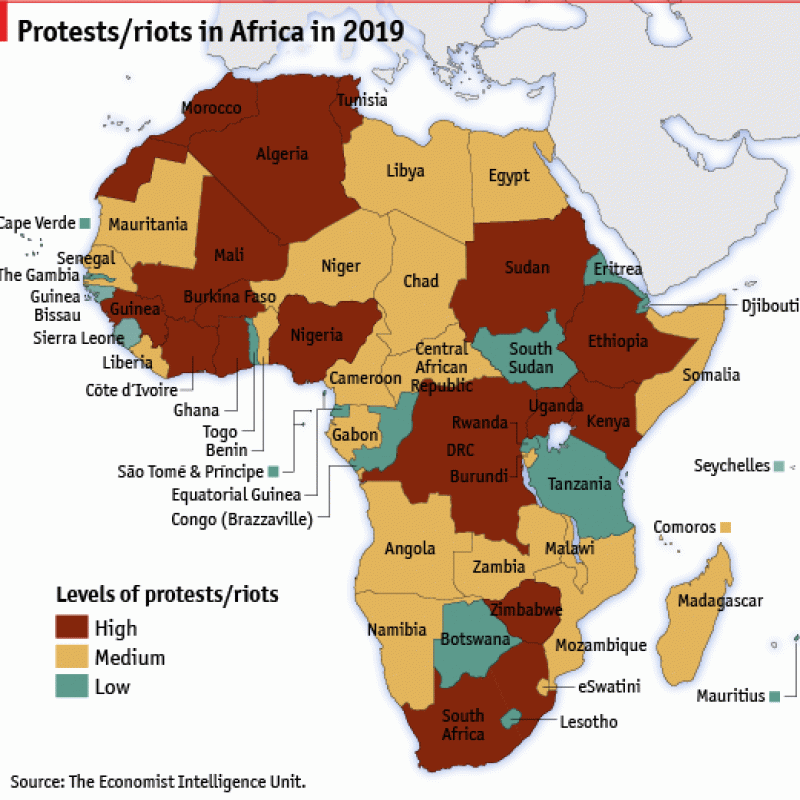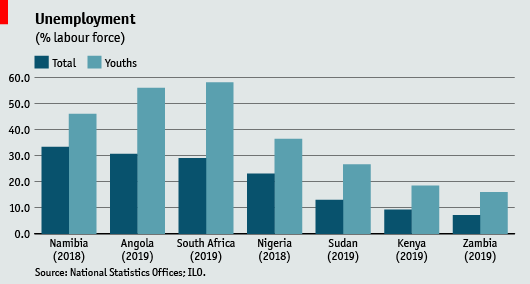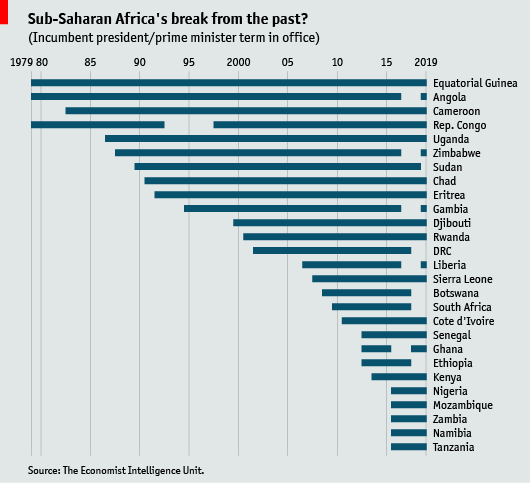Analysing Protests in Sub-Saharan Africa
The year 2019 is now commonly referred to as a “year of protests” which spanned the globe, from Hong Kong to the Netherlands, to Africa. The Economist’s intelligence unit filed a report in the from of an article under the header of Central African Republic titled “Protests in Sub-Saharan Africa” with complementary figures detailing where protests in Africa took place and by what order of magnitude.

The Economist depicts the protests as having “reflected a view that governments are self-serving institutions that have been either unable or unwilling to tackle sensitive issues relating to economic need and opportunity, political oppression and freedoms, as well as poor governance and corruption.” and that “these concerns have been on clear display during the protests witnessed in Sub-Saharan Africa during 2019.” The initial info-graphic (displayed above) is rather limited in what it tells the reader, displaying protests and riots together despite being two distinct happenings and working with a scale of high/medium/low. Judging by this information one would, for example, assume that South Sudan was relatively spared from protests and riots against the government, even though in 2019 the country was embroiled in a civil war.

Subsequent graphs attempt to support the information the first one provides. Youth unemployment and a lack of political freedoms are named as the three big factors in inciting the protests of 2019. For this the Economist presents three graphs; one by the National Statistics Offices, another made by their own team and the last one by the EIU Democracy Index from 2018. Income inequality in Sub-Saharan Africa is prevalent, with besides South Africa understandably ranking the highest in that regard, Namibia, Zambia, the Central African Republic, Lesotho, Mozambique, Botswana, eSwatini, Guinea-Bissau and the Republic of Congo are also in the top 20.

The article ties leadership change to a hope for systematic change, with Abiy Ahmed in Ethiopia, João Lourenço in Angola, Cyril Ramaphosa in South Africa, Félix Tshisekedi in the DRC and Muhammadu Buhari in Nigeria being sworn in as new leaders in their respective countries in 2019. Each promised a break from the past, a platform of economic and social reforms, a fight against corruption and a commitment to resolve national conflicts. Abiy Ahmed had notably succeeded in this regard, with him being awarded the Nobel peace prize for resolving the border conflict with Eritrea. The second graph tries to illustrate this idea of a break with the past by listing Sub-Saharan African countries’ periods with a single leader and intermittent breaks where they apply.
The difficulty of replacing incumbent leaders and parties is then directly linked to the grievances of African youths and thus to the protests. Here again there are some interesting observations to be made; for example South Africa’s Ramaphosa being presented as a force of change and reason for hopeful optimism, displayed in the graph as a gap in the term period of the one leader, one party system other African countries still cope with. Ramaphosa is a member of the ANC, the dominant political party in the country. So were all the previous leaders of South Africa since the end of apartheid. On 8 May 2019, the African National Congress led by President Ramaphosa won 57.50% of the vote in the 2019 South African general election. Ramaphosa was subsequently elected unopposed to his first full term as president by the National Assembly on 22 May 2019. On 19 July 2019, the Public Protector, Busisiwe Mkhwebane, released a report in which she claimed that Ramaphosa had intentionally misled the Parliament of South Africa over the controversial Bosasa donations to his CR17 ANC presidential campaign. COPE Leader Mosiuoa Lekota called for Ramaphosa to be impeached while DA Leader Mmusi Maimane proposed the establishment of an ad hoc committee to effectively investigate these allegations. Ramaphosa briefed the nation on 21 July 2019 and described the report as "fundamentally flawed" and called for a judicial review of Mkhwebane's findings. None of these things inspire confidence in Ramaphosa’s leadership making that break with the past the article is all about, yet his tenure is still listed as separate from what came before him. It seems that the Economist mistook the ANC’s populist bent for genuine democratic change, with the hindsight of today that mistake becomes all too evident.
To the Economist’s credit however, in the closing statement of their article they do mention that a loss of momentum for these new Sub-Saharan African leaders could reignite protests and riots in 2020. Ironically enough they predict that “the ride could easily become much bumpier in 2020.”, which it most certainly did. The coronavirus pandemic nearly makes this article obsolete, were it not for the fact that the underlying factors behind these protests in 2019 have not only remained, but became exacerbated as 2020 went on.


Mirjam de Bruijn
October 14, 2020 (16:46)
It is really insightful to see how the figures that probably have nothing to do with each other (behind it is also a certain theory) are used to proof a correlation. You show with the case study on South Africa how in fact it does not work. But the superficial reader will especially remember the impressive figures and the relation with protest. It is a style of the economist; this is the way they convince their readers.